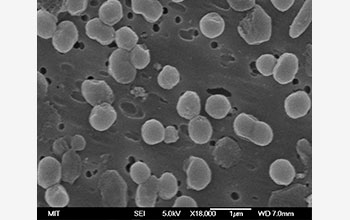Multimedia Gallery
Scanning electron micrograph of marine microbe Prochlorococcus
A scanning electron micrograph of the marine microbe Prochlorococcus.
More about this image
Prochlorococcus is a photosynthetic bacterial species essential to the marine ecosystem. It's estimated that billions of these single-celled creatures live in the oceans, forming the center of the marine food web. They occupy a range of ecological niches based on temperature, light, water chemistry and interactions with other species.
Scientists at the Massachusetts Institute of Technology, seeking to learn more about the diversity within this single species, performed a cell-by-cell genomic analysis of a wild population of Prochlorococcus living in a milliliter of ocean water -- less than a quarter of a teaspoon -- and found hundreds of distinct genetic subpopulations.
The researchers found that each subpopulation in those few drops of water is characterized by a set of core gene alleles linked to a few associated flexible genes -- a combination the scientists call the "genomic backbone." This backbone gives the subpopulation a finely tuned ability to fill a particular ecological niche. Diversity also exists within backbone subpopulations; most individual cells in the samples carried at least one set of flexible genes not found in any other cell in its subpopulation.
"In spite of the constant mixing of the oceans," says George Gilchrist, a program director in the National Science Foundation's Division of Environmental Biology, "variations in light, temperature and chemistry create unique habitats that evolution has filled with an enormous diversity of populations over millions of years."
Adds David Garrison, a program director in NSF's Division of Ocean Sciences, "The results will change the way marine ecologists think about how planktonic microbes and, in turn, planktonic communities may respond to climate and environmental change."
Partial funding for this research came from NSF's Divisions of Environmental Biology and Ocean Sciences and by the Center for Microbial Oceanography, an NSF Science and Technology Center, among others.
To learn more, see the NSF press release Octillions of microbes in the seas: Ocean microbes show incredible genetic diversity.
(Date of Image: 2004-2014)
Credit: Anne Thompson, MIT
Images and other media in the National Science Foundation Multimedia Gallery are available for use in print and electronic material by NSF employees, members of the media, university staff, teachers and the general public. All media in the gallery are intended for personal, educational and nonprofit/non-commercial use only.
Images credited to the National Science Foundation, a federal agency, are in the public domain. The images were created by employees of the United States Government as part of their official duties or prepared by contractors as "works for hire" for NSF. You may freely use NSF-credited images and, at your discretion, credit NSF with a "Courtesy: National Science Foundation" notation.
Additional information about general usage can be found in Conditions.
Also Available:
Download the high-resolution JPG version of the image. (837 KB)
Use your mouse to right-click (Mac users may need to Ctrl-click) the link above and choose the option that will save the file or target to your computer.



 All images in this series
All images in this series